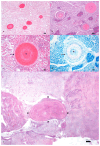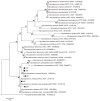Systemic Granulomatosis in the Meagre Argyrosomus regius: Fishing for a Plausible Etiology
- PMID: 39728937
- PMCID: PMC11680436
- DOI: 10.3390/vetsci11120597
Systemic Granulomatosis in the Meagre Argyrosomus regius: Fishing for a Plausible Etiology
Abstract
Meagre (Argyrosomus regius) is one of the fast-growing species considered for sustainable aquaculture development along the Mediterranean and Eastern Atlantic coasts. The emergence of Systemic Granulomatosis (SG), a disease marked by multiple granulomas in various tissues, poses a significant challenge in meagre aquaculture. In the current study, we investigate the association of Mycobacterium spp. and SG in offshore aquaculture facilities in Sardinia, Italy. A total of 34 adult seemingly healthy meagre were arbitrarily collected and analyzed, combining histological, microbiological, molecular, metagenomics, and in situ techniques to investigate the presence of pathogens. Ziehl-Neelsen (ZN), periodic acid-schiff (PAS), and Giemsa stains were performed for the detection of acid-fast bacteria, common parasites, and fungi within granulomas, respectively. Granulomas were detected in 91% (31/34) of fish. The affected organs were kidney (88%), liver (47%), heart (41%), intestine (17.6%), and brain (5%). Acid-fast staining, along with Mycobacterium spp. specific quantitative PCR (qPCR), in situ hybridization (ISH) assay, and microbiological analyses showed negative results for the detection of Mycobacterium spp. and other bacteria implicated in granuloma formation. However, PCR amplification and sequencing of the 65-kDa heat shock protein gene revealed the presence of M. chelonae in 13% of both formalin-fixed and frozen liver tissues. Bacterial isolation failed to detect nontuberculous mycobacteria (NTM) and other bacteria typically associated with granulomas. Consistently, the use of an M. chelonae-specific probe in ISH failed to identify this bacterial species in granulomas. Collectively, results do not support the role of M. chelonae in the development of granulomas and suggest rejecting the hypothesis of a potential link between NTM and SG.
Keywords: Mycobacterium chelonae; fish aquaculture; granulomas; in situ hybridization assay.
Conflict of interest statement
The authors declare no conflicts of interest.
Figures





Similar articles
-
Histological assessment of systemic granulomatosis progression in meagre Argyrosomus regius during cage ongrowing phase.Dis Aquat Organ. 2021 Jul 15;145:165-172. doi: 10.3354/dao03606. Dis Aquat Organ. 2021. PMID: 34263731
-
Effect of Cold Smoking and Natural Antioxidants on Quality Traits, Safety and Shelf Life of Farmed Meagre (Argyrosomus regius) Fillets, as a Strategy to Diversify Aquaculture Products.Foods. 2021 Oct 21;10(11):2522. doi: 10.3390/foods10112522. Foods. 2021. PMID: 34828803 Free PMC article.
-
Outbreak of Sciaenacotyle panceri (Monogenea) on cage-reared meagre Argyrosomus regius (Osteichthyes) from the western Mediterranean Sea.Dis Aquat Organ. 2009 Sep 23;86(2):169-73. doi: 10.3354/dao02115. Dis Aquat Organ. 2009. PMID: 19902846
-
Cutaneous infections due to nontuberculous mycobacteria: histopathological review of 28 cases. Comparative study between lesions observed in immunosuppressed patients and normal hosts.J Cutan Pathol. 2000 Mar;27(3):124-9. doi: 10.1034/j.1600-0560.2000.027003124.x. J Cutan Pathol. 2000. PMID: 10728814 Review.
-
The emerging farmed fish species meagre (Argyrosomus regius): how culinary treatment affects nutrients and contaminants concentration and associated benefit-risk balance.Food Chem Toxicol. 2013 Oct;60:277-85. doi: 10.1016/j.fct.2013.07.050. Epub 2013 Jul 27. Food Chem Toxicol. 2013. PMID: 23900006 Review.
References
-
- Monfort M.C. Studies and Reviews-General Fisheries Commission for the Mediterranean. Food and Agriculture Organization of the United Nations (FAO); Rome, Italy: 2002. Present Market Situation and Prospects of Meagre (Argyrosomus regius), as an Emerging Species in Mediterranean Aquaculture.
-
- Duncan N.J., Estévez A., Fernández-Palacios H., Gairin I., Hernández-Cruz C.M., Roo J., Schuchardt D., Vallés R. Advances in Aquaculture Hatchery Technology. Elsevier; Amsterdam, The Netherlands: 2013. Aquaculture Production of Meagre (Argyrosomus regius): Hatchery Techniques, Ongrowing and Market; pp. 519–541.
-
- F.A.O. FishStatJ, a Tool for Fishery Statistics Analysis Release: 4.04.00. [(accessed on 5 December 2023)]. Available online: https://www.fao.org/fishery/en/statistics/software/fishstatj.
-
- Ghittino C., Manuali E., Latini M., Agnetti F., Rogato F., Agonigi R., Colussi S., Prearo M. Caso Di Granulomatosi Sistemica in Ombrina Boccadoro (Argyrosomus regius) e Raffronto Con Le Lesioni Istologiche Presenti Nell’ Orata. Ittiopatologia. 2004;1:59–67.
-
- Katharios P., Kokkari K., Papadaki M., Papandroulakis N. Systemic Granulomas in Cultured Meagre, Argyrosomus regius. Aquac. Eur. 2011;11:537–538.
LinkOut - more resources
Full Text Sources
Molecular Biology Databases
Miscellaneous

